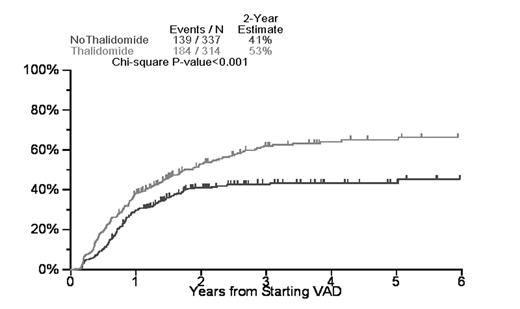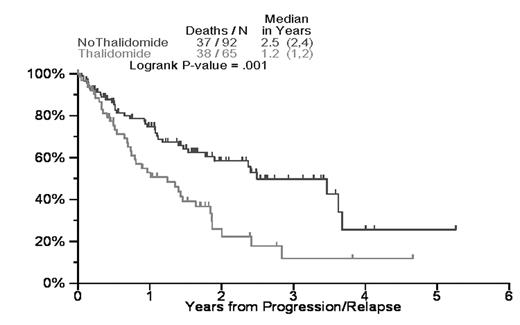Abstract
Background: Autotransplants have become the standard of care for patients with MM. TT2, a prospective randomized phase III trial, evaluated whether adding T, effective in end-stage MM, could improve the outcome of patients receiving melphalan (MEL200)-based tandem autotransplants.
Methods: Between October 1998 and February 2004, 668 patients were randomized to receive T (n=323) or no T (n=345), with the primary objective to increase the 5-yr EFS rate from 40% to 50%. TT2 consisted of 4 phases: induction with VAD-DCEP-CAD with PBSC collection, DCEP; tandem autotransplants with MEL 200; D-PACE consolidation; interferon maintenance with added DEX pulsing during the 1st year. The median follow-up is 3 years.
Results: Patient baseline characteristics in the 2 arms were similar. T increased CR from 41% to 59% (p<0.001) (Figure 1a); 5-yr EFS was superior for the T arm (54% vs. 42%, p=0.017), whereas 5-yr OS was not different at 67% and 62% (p=0.9), due to shorter post-relapse survival of patients initially randomized to T (13 vs 32mos, p<0.001) (Figure 1b). Of 437 patients with interphase FISH data, amp1q21 and chromosome 13q14 deletion (del13q14) both conferred short OS (p<0.001, p=0.003) and EFS (p<0.001, p<0.001), independent of metaphase cytogenetic abnormalities (CA) (p<0.001); these 3 genetic features alone accounted for 35% of OS and 28% of EFS variability. T improved EFS both in patients without and with one or more of these 3 genetic abnormalities. High amp1q21 indices accounted for shorter post-relapse survival (p<.001), independent of initial T randomization (p=.5). The post-relapse therapies were similar among the 2 arms and included T in all previously not on T and most previously on T, often together with bortezomib = DEX (VTD regimen; Barlogie, Blood, 2004).
Conclusions: Intensive chemotherapy before and following tandem autotransplants in TT2 effected unprecedented high 5-yr EFS (48%) and OS rates (65%). T significantly increased CR frequency and extended EFS but not OS. A shorter post-relapse survival could be traced to high amp1q21 index at relapse (more often present on T arm).
Author notes
Corresponding author



This feature is available to Subscribers Only
Sign In or Create an Account Close Modal